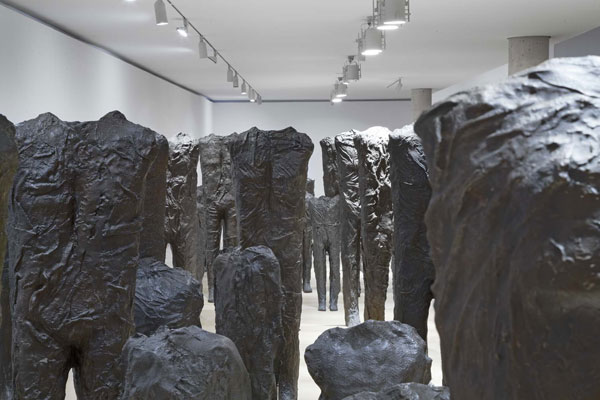Magdalena Abakanowicz
Born in Poland in 1930. When the artist was just nine years old, the Germans invaded Poland and started World War II, whose dramatic aftermath wreaked terrible destruction, killing a quarter of a million Poles deporting the survivors to concentration camps, and razing cities, especially Warsaw, to the ground. These dramatic historic circumstances turned her first years before the war, her early childhood surrounded by forests and immersed in the forces of nature, into elements that shaped her memory, her dreams and her imagery, where she took refuge to isolate herself and shelter from the reality in which she lived, thus bearing a crucial influence on the artistic work she was to produce over the years. From her very first works made at the end of the fifties, one of the constant features of her oeuvre can already be found: a fascination with energy, monumentality and also the mystery of the natural world, expressed in organic motifs and biological and corporal forms, shunning the limits of the “immediate” imposed by contemporary reality and seeking roots in universality. Nature is always present throughout her career although in different forms. Among them, it is worth emphasising the series War Games, which she made between 1987 and 1994, including the pieces Giver, Anasta, Ancestor and Zadra among other sculptures, fashioned from the trunks of fallen trees and representing the physical vitality of human bodies in clear contrast with the wounds inflicted by the violence of warfare. In the mid sixties, coinciding with the moment when the conception of art was growing considerably to embrace new fields, materials, media and artistic languages, Abakanowicz began to produce the first works that were to gain her international fame, permitting her to leap across the boundaries of her country and escape from the marginality and isolation that Poland remained steeped in until the fall of the Iron Curtain in 1989. During her studies at the Academy she had attended several classes of textile design so that she was familiar with the practice of weaving, printing and designing fibres, with which she began to make large-sized woven structures of natural materials endowed with extraordinary tactile qualities. These abstract forms of organic metaphors were baptised Abakans, a name the artist herself used for these works from that time onwards. The pliability of the materials together with the fluidity of the forms and surfaces contrasted with the perfect finish of the manufactured products. After 1973 her interest in the organic and biological universe permitted her to find sources of inspiration in organic metaphors contained in the natural sciences, in biology and in the human body. At that time she made Embryology, which marked an important change in her trajectory because of the introduction of new soft but manufactured materials like ropes, sacks, nylon, cotton, gauze, etc. The human figure appeared for the first time in the series Heads (1973) and Backs (1976), made from the same humble organic materials as the rest of her pieces at the time, characterised by an intense oppressive symbolism that dominates this heterogeneous group of serialised works made up of a conjunction of bodies whose fragmentation, mutilation and deformation are reminiscent of the suffering, fragility and vulnerability of the human being, no doubt one of the major themes of her work. However, in 1985 another important change took place that radically transformed the character of her work from then on: she began to cast her figures in bronze. The use of this material allowed her to create permanent monumental sculptures that could be installed outdoors and that seemed to be lost in intemporality. The first of these was Katarsis, comprising 33 hollow gigantic headless figures like tree trunks that she made for the collection of outdoor sculptures that Giuliano Gori has created at Villa Celli in Tuscany. She then continued to produce monumental sculptures to be installed in the open air, among which the following deserve special mention: Negev, of 1987, situated in the sculpture garden of the Israel Museum in Jerusalem, Space of the Dragon, of 1988, in the Olympic Park in Seoul, and Agora, recently made for Grant Park in Chicago. All these works that have formed a network of organic microcosms since the seventies are spread out and occupy the places where they are exhibited, which then becomes part of them, producing unique spaces created to make the spectator reflect about human experience, which is the ultimate aim of Abakanowicz’s oeuvre.



